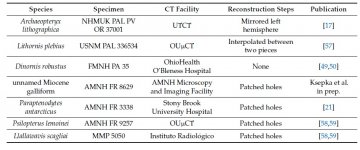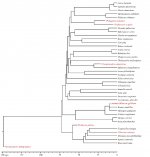albertonykus
Well-known member
Early, C.M., R.C. Ridgely, and L.M. Witmer (2020)
Beyond endocasts: using predicted brain-structure volumes of extinct birds to assess neuroanatomical and behavioral inferences
Diversity 12: 34
doi: 10.3390/d12010034
https://www.mdpi.com/1424-2818/12/1/34/htm
The shape of the brain influences skull morphology in birds, and both traits are driven by phylogenetic and functional constraints. Studies on avian cranial and neuroanatomical evolution are strengthened by data on extinct birds, but complete, 3D-preserved vertebrate brains are not known from the fossil record, so brain endocasts often serve as proxies. Recent work on extant birds shows that the Wulst and optic lobe faithfully represent the size of their underlying brain structures, both of which are involved in avian visual pathways. The endocasts of seven extinct birds were generated from microCT scans of their skulls to add to an existing sample of endocasts of extant birds, and the surface areas of their Wulsts and optic lobes were measured. A phylogenetic prediction method based on Bayesian inference was used to calculate the volumes of the brain structures of these extinct birds based on the surface areas of their overlying endocast structures. This analysis resulted in hyperpallium volumes of five of these extinct birds and optic tectum volumes of all seven extinct birds. Phylogenetic ANCOVA (phyANCOVA) were performed on regressions of the brain-structure volumes and endocast structure surface areas on various brain size metrics to determine if the relative sizes of these structures in any extinct birds were significantly different from those of the extant birds in the sample. Phylogenetic ANCOVA indicated that no extinct birds studied had relative hyperpallial volumes that were significantly different from the extant sample, nor were any of their optic tecta relatively hypertrophied. The optic tectum of Dinornis robustus was significantly smaller relative to brain size than any of the extant birds in our sample. This study provides an analytical framework for testing the hypotheses of potential functional behavioral capabilities of other extinct birds based on their endocasts.
Beyond endocasts: using predicted brain-structure volumes of extinct birds to assess neuroanatomical and behavioral inferences
Diversity 12: 34
doi: 10.3390/d12010034
https://www.mdpi.com/1424-2818/12/1/34/htm
The shape of the brain influences skull morphology in birds, and both traits are driven by phylogenetic and functional constraints. Studies on avian cranial and neuroanatomical evolution are strengthened by data on extinct birds, but complete, 3D-preserved vertebrate brains are not known from the fossil record, so brain endocasts often serve as proxies. Recent work on extant birds shows that the Wulst and optic lobe faithfully represent the size of their underlying brain structures, both of which are involved in avian visual pathways. The endocasts of seven extinct birds were generated from microCT scans of their skulls to add to an existing sample of endocasts of extant birds, and the surface areas of their Wulsts and optic lobes were measured. A phylogenetic prediction method based on Bayesian inference was used to calculate the volumes of the brain structures of these extinct birds based on the surface areas of their overlying endocast structures. This analysis resulted in hyperpallium volumes of five of these extinct birds and optic tectum volumes of all seven extinct birds. Phylogenetic ANCOVA (phyANCOVA) were performed on regressions of the brain-structure volumes and endocast structure surface areas on various brain size metrics to determine if the relative sizes of these structures in any extinct birds were significantly different from those of the extant birds in the sample. Phylogenetic ANCOVA indicated that no extinct birds studied had relative hyperpallial volumes that were significantly different from the extant sample, nor were any of their optic tecta relatively hypertrophied. The optic tectum of Dinornis robustus was significantly smaller relative to brain size than any of the extant birds in our sample. This study provides an analytical framework for testing the hypotheses of potential functional behavioral capabilities of other extinct birds based on their endocasts.






